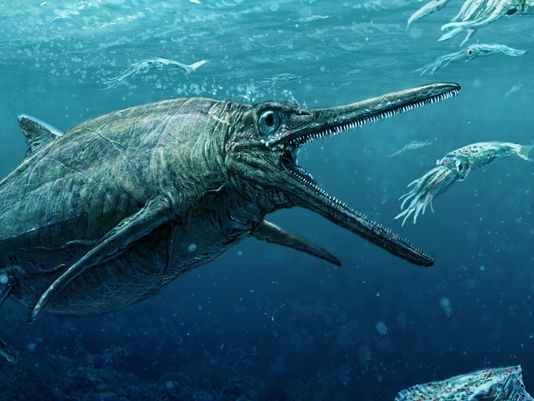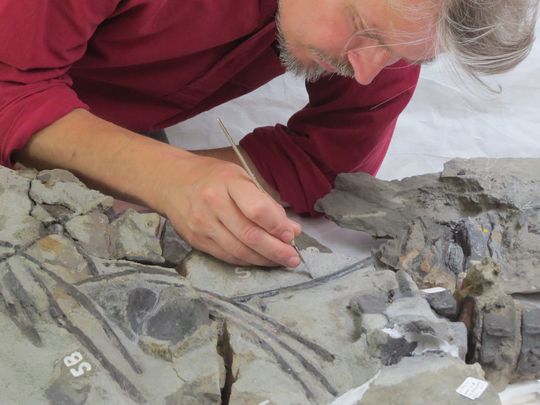A Jurassic sea monster in all its prehistoric glory has finally re-emerged into the light after 50 years cooped up in a museum storage room in Scotland.
Nicknamed the Storr Lochs Monster, the newly revealed creature is actually an ichthyosaur, a kind of extinct swimming reptile that ruled the waves while the dinosaurs reigned over the land. Over their long history, ichthyosaurs evolved into enormous beasts akin to the whales of their day.This fossil, though not a giant, is a scientific prize, scientists say. At roughly 170 million years old, it lived during the Middle Jurassic, a somewhat mysterious period for paleontologists.

An artist’s rendering of what the Storr Lochs monster looked like in the Jurassic period
(Photo: Todd Marshall)
“The Middle Jurassic is one of the most poorly known times in the history of dinosaurs and in the history of other reptiles like ichthyosaurs,” says University of Edinburgh’s Steve Brusatte, part of the team examining the fossil. The “spectacular” find, he says, “has a lot of potential.”
It took two generations of one Scottish family to bring the Storr Lochs Monster into the spotlight. In 1966, Norrie Gillies, who ran the hydropower plant on Scotland’s Isle of Skye, was strolling the shore near the Storr Lochs power station when he spotted some bones sticking out of a rock.
Gillies had collected many small fossils, but “he realized (this) was on a different scale altogether,” says his son Allan Gillies, an engineer for SSE, the successor to his father’s employer. “It wasn’t the sort of thing you kept in your back yard.”
The fossil was taken to a storage facility belonging to what is now National Museums Scotland. But it was encased in rock harder than concrete, and extracting it would have taken substantial skill – and money. When Norrie Gillies died in 2011, his fossil still wore its stone shroud.A few years later, Allan Gillies read about Brusatte’s research and contacted the scientist about the big fossil found near the hydropower station. Perhaps, Gillies said, his employer would pay for the fossil’s liberation from the rock.
And so it proved. After removal of its stone cloak, the ichthyosaur has been revealed as a barrel-chested animal about as big as a bottle-nosed dolphin. The fossil was unveiled Monday in Scotland.
“The father found it, and the son really helped with the fundraising,” Brusatte says. He and his colleagues don’t yet know which species it is, but Brusatte suspects it hunted fish and squid and, like other ichthyosaurs of its time, had hundreds of teeth and enormous eyes, which would’ve helped it see through the gloom of the deep seas.
Other scientists are keen to see what the new fossil might reveal.
“This new ichthyosaur can and, I’m sure, will tell us a good few things about ichthyosaur paleobiology, and marine reptiles more generally,” says Benjamin Moon of Britain’s University of Bristol. Very little fossil material is known from that time period, he says, so this new specimen will help fill a gap.
The Storr Lochs Monster is not the only ichthyosaur to swim into the 21st century out of long hiding. A 20-inch baby ichthyosaur and the fossil of an ichthyosaur as long as a subcompact car have recently been turned up by Dean Lomax of Britain’sUniversity of Manchester, who has been scouring Britain’s small museums for overlooked sea monsters.
“I contact a museum and say, ‘I’m looking for ichthyosaur specimens,’” he says. “Sometimes you just get lucky.”
Courtesy: Article by Traci Watson, Special for USA TODAY.
Key: WFS,World Fossil Society,Riffin T Sajeev,Russel T Sajeev



 September 5th, 2016
September 5th, 2016  Riffin
Riffin 
 Posted in
Posted in  Tags:
Tags: 